Article and all photos by Joe Mock, BaseballParks.com
All rights reserved
 |
The Tampa Bay Devil Rays’ AA team has played in a beautiful, modern ballpark the past few years. Cracker Jack Stadium, on the grounds of Walt Disney World near Orlando, was home not only to the Orlando Rays of the Southern League, but also to the Atlanta Braves for their spring exhibition games. Unfortunately, when the Braves moved north each spring, so did the crowds, leaving the Rays playing in front of miniscule gatherings.
| Ballpark Stats |
| First game: April 16, 2004 |
| Capacity: 4,500 fixed seats, about 2,500 more are permitted for General Admission |
| Price: $26 million |
| Home dugout: 1B side |
| Field points: North by northeast |
| Playing surface: grass |
| Betcha didn’t know: Park was built on the site of a Confederate prison |
Meanwhile, the city of Montgomery, AL had been without a team in the affiliated Minors since the Rebels moved about 90 miles north to become the Birmingham Barons after the 1980 season. Montgomery is indeed quite a sports town, though, and the civic leaders there had been working for years to lure a team back to Alabama’s capital city. Since the Rebels had been in Class AA, no one wanted to settle for a team in Class A this go-round. So when the attendance in Orlando hit the skids, the franchise was ripe for the picking for Montgomery.
Of course, as is usually the case with a franchise shift, it took a new stadium to make things happen. The relocated team, now called the Biscuits, made its debut in Montgomery on the same day as the ballpark, on April 16, 2004. And Riverwalk Stadium is no thrown-together facility, either. The planning and execution of this park make it one of the most fascinating in the Minors.
The Setting
The trend for new Minor League ballparks has been to place them near downtown. This allows the city to get a some mileage out of the park, placing it where fans will be exposed to other landmarks and attractions. That is certainly the case here in Montgomery. Riverwalk Stadium, as its name implies, is located quite close to the Alabama River, which flows through downtown. This means that the park is located just a few feet from an amphitheater on the banks of the river, and just two blocks away from the city’s positively gorgeous old train station. Union Station now houses Montgomery’s visitors center, so please make a point of stopping by when you come to town. It’s as pretty as any train station in the country.
From a historical perspective, the land on which the stadium now sits once housed a prison used by the Confederacy to hold Yankee soldiers. The year was 1862, and almost 200 of the 700 Union military men held in the deplorable conditions here died. No doubt, the prisoners were brought in by train.
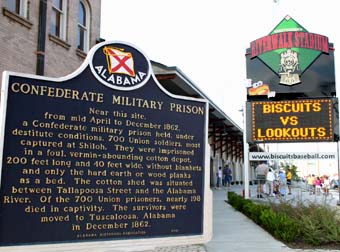  |
And speaking of railroads, active tracks run just a few feet from the walkway above left field. A couple of times a game, huge trains come rolling through, blaring their horns. In this way, it is quite reminiscent of the coal trains that run above the right-field wall at Watt Powell Park in Charleston, WV. Obviously, the railroad theme is central to Riverwalk Stadium.
The ballpark’s location, by the way, means that you can catch pretty views of it from the scenic overlook on Bell Street just west of downtown, and from the northbound side of the I-65 bridge that crosses the Alabama River.
The Exterior
Several noteworthy ballparks have incorporated existing buildings into their designs, some with spectacular results. The Western Metal Supply Building at PETCO Park in San Diego houses restaurants, party suites and even serves as the left-field foul “pole.” An abandoned building in downtown Louisville was preserved to form the entryway to Louisville Slugger Field. Houston’s long-forgotten Union Station was brought back to life by Minute Maid Park. And everyone knows about the B&O Warehouse at Baltimore’s Camden Yards.
Arguably, the best use of an existing building in the Minors is in Montgomery. Because the city’s train station is only two blocks away from the stadium site, there were several “train sheds” on the land where they wanted to build. These sheds date back over a century, but they had long since been abandoned. The architects for the project, HOK, decided to keep one that was right along Tallapoosa Street and incorporate it into the design of the park (see the photo below). This means that the exterior of the park that most passersby see is quite similar to what has stood there for decades.
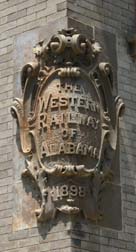  |
At the western end of this shed, at the corner of Tallapoosa and Coosa Streets, is a corner-piece that dates the building back to 1898. It’s well above eye level, so make a point of looking for it when you visit this park.
Around the corner on Coosa Street, a similarly ancient building was renovated to serve as the team’s offices and the retail store. Make sure you notice the fine tile work on the porch of the entryway there.
All in all, the exterior is quite nice, especially since it’s not a new building made to look old. No, it is old!
The Design
So the Train Shed is an integral part of Riverwalk Stadium. Not only does it house the ticket windows, walking through it is the main way you enter the ballpark (see the photo below on the left). The ground floor of this long, skinny building also includes restrooms and concession stands (center picture) as well as a beautifully appointed lounge for Executive Club season-ticket holders and suite dwellers called, cutely, the Club Car Bar (right photo). It’s the upper level of the Shed, though, that is even more impressive — the word “genius” comes to mind. That’s where you’ll find six luxury suites, complete with little overhangs over the seating areas in front of the suites.
 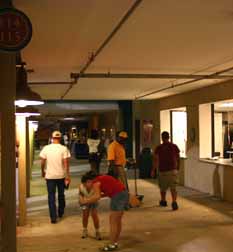  |
This Shed is at the rear of part of the main seating bowl, running parallel to the first-base line. A wide walkway separates the seats from the building. A great touch (and I love “nice touches” — things that didn’t have to be done, but are nice to have at a park) is that there are spotlights recessed into the concrete at the base of the outer wall of the Shed, thereby providing beautiful illumination of the building for night games.
But train sheds don’t usually have 90-degree angles in the middle of them (because no train would be able to turn that sharp of a corner inside them!), so this building, as wonderful as it is, can’t do anything for the third-base line. Therefore, the “north wing” had to be constructed from scratch. This curves from just behind home plate well beyond third base. It doesn’t really have a lower level, but its upper floor contains the press box and 14 additional luxury suites. This structure provides shade for the concourse and part of the seats on the third-base side.
Consequently, the walkway at the rear of the main seating bowl is technically an “open concourse,” since you can always look down at the field while walking to the restroom or concession stand. More impressively, though, is that this is what I like to call a “360-degree concourse,” which is sorely lacking at so many new Minor League parks. Indeed, if you visit Riverwalk Stadium and fail to take a stroll around the entire site on this concourse, then you will have done yourself a disservice.
On this walk, you’ll encounter the following: a wonderful vantage point from the top of the left-field wall (which is 15 feet above the field, so you have an elevated view of the action — see photo below); an up-close-and-personal encounter with the trains that roll by just a couple of feet away; fabulous landscaping around the center-field picnic area; and the nifty berm area in right field. While near the right-field line, stop to notice the huge bulge in the right-field wall that protrudes into fair territory. While it would be nice to think that some architect in Kansas City dreamed up this concept because of the crazy bounces that the right-fielder will have to play, the truth is that this was a necessity because of the trunk lines of fiber-optic cables running through this area from a switching station just a few feet away. This reminds one of the huge hump in the playing field at Philadelphia’s long-demolished Baker Bowl, a rise in the ground that couldn’t be made level because a train tunnel ran right underneath!
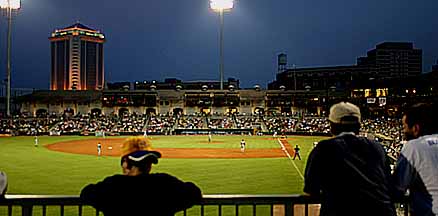 |
Jim Tocco, the exceptional play-by-play man of the Biscuits, pointed something out to me that I hadn’t noticed on my own. One spot you should make every effort to visit is the Locomotive Loft on the upper level of the north wing, near the left-field foul pole. Not only is it the spot most likely to offer a breeze on a muggy Montgomery night, it provides a spectacular view of the action below and the gleaming AmSouth building behind first base and, in the distance, the Alabama State Capitol. To your left are the train tracks and the river. This is a special spot.
While HOK did a remarkable job with this ballpark design and incorporating the Train Shed, there are two areas that concern me somewhat. First, the pitch of the main seating bowl isn’t very steep, making it a little challenging to see home plate over the heads of the other fans if your seat is well down the third-base line. In this regard, it reminds me of another landmark HOK project, Oriole Park at Camden Yards. The rear rows in the field level seats simply weren’t elevated enough in Baltimore’s stadium, plus the sections down the lines weren’t twisted to face the infield. If you were unlucky enough to be one of the many Oriole fans who purchased season tickets in one of those sections, you were quite unhappy. The comparable sections in Riverwalk Stadium aren’t as bad, but it would’ve been better if the bowl had been a little steeper.
The other problem area I noticed is that folks in the seats well down the third-base line have a very difficult time viewing the scoreboard, which is not far from the top of the left-field fence and, hence, faces directly toward first base. I understand that the team recognizes that this is a problem, and they are currently contemplating adding an auxiliary scoreboard somewhere on the first-base side of the field.
So for the time being, if you can help it, try not to sit near the left-field foul pole!
The Essentials
So the park is really pretty, but what you really want to know is how high are the prices, how good is the food, are the souvenirs any good and what can I do with my kid when he gets restless. Relax, BASEBALLPARKS.COM exists to tell you what you really need to know about ballparks!
I find that the average price for parking at the Class AA level is about $3. In the lots adjacent to Riverwalk Stadium, it’s $4, but it is also obvious that the city created significant new parking acreage for this park, so I can’t fault them for charging a little more than elsewhere. The tickets are also slightly more than at other AA parks, but not as high as at the really new ones (and not even close to the atmospheric prices in Frisco, TX!). “Super Box” seats in Montgomery are $10, and all other reserved seats in the stadium (aside from the season-ticket-only Executive Club sections right behind home) are $8. If you want to sit out on the grass down the first-base line or in right field, general admission is $6.
The food prices are very reasonable: $3 for a straightforward hot dog; $3.75 for an exceptionally good brat (and only $5 for a footlong brat); $5 for a healthy quantity of chicken tenders (without fries). Everything we sampled was quite good.
But if you’re wondering if Riverwalk Stadium has a “signature food” item, the answer is a resounding yes: biscuits! A stand right behind home plate serves beautiful, wonderful biscuits. You get a pair of plain biscuits for $2.50, and you then add your own light syrup, dark (thick, sticky) syrup or jelly. Delicious! You can also purchase a chicken biscuit or one with ham for $4.
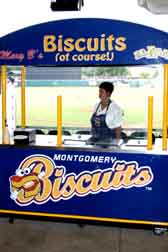 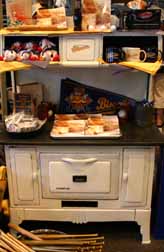 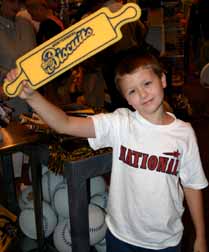 |
The retail store, adorably named The Biscuit Basket, is large and full of great logo merchandise. You can’t beat a ball cap or a kids T-shirt with a walking biscuit on it! The merchandise itself is beautifully displayed, including a unique display case: an old-style stove (see center photo above)! A lot of the merchandise has a clever “Biscuit theme.” For instance, while most teams have a We’re Number One foam finger for sale, the Biscuit Basket offers a foam rolling pin (see above right). Be advised, though: you’ll be sure that they’ve miscalculated your total when you take your items to the counter. That’s because the sales tax is a steep 10% in Montgomery.
I, for one, am thankful that the team elected not to utilize any of the national companies to handle the concession stands or the souvenir shop. Things tend to look the same from park to park when teams contract with these corporations. Instead, the Biscuits front office decided to do it all themselves, although I’m sure it was a great deal more hassle for them to do so. The result, though, is a wonderful, one-of-kind store and unique and fun food offerings.
Are there diversions for the kids? Sure, a lovable mascot named Big Mo and an extensive play area in the left-field corner called, appropriately enough, “Big Mo’s Dugout.”
And I have to comment on the “train theme” at Riverwalk Park. Obviously, with a Train Shed behind first base and active railroad tracks a few feet beyond left field, it’s appropriate to carry out this theme throughout the park. Thankfully, the Biscuits didn’t over-do it by dressing the ushers as train conductors or use cutesy train puns to name the menu items. They did do a clever job of naming areas within the park, though: the Boxcar Cafe in center field; the Whistle Stop Grille in left field; and the aforementioned Locomotive Loft and Club Car Bar.
Carrying out a theme around a ballpark can be tricky business (the one in Robstown, TX really overdoes it with its World War II aviation theme), but I think Montgomery is in the same A-plus category as Brooklyn, with its Coney Island amusement-park motif, and Albuquerque with its whimsical, cartoonish theme.
Summary
This is a beautiful park — made even more beautiful because it truly does combine the “new” with the “old.” The railroad theme is carried out to just the right extent, without being too overbearing. Perhaps best of all, there is no corporate-sponsorship name on this facility (although it struck me that “Martha White Flour Field” might be appropriate for a team named the Biscuits!).
The park is not without its faults, but they are by no means major ones. Just try not to sit in the left-field corner!
Overall, I am extremely impressed with Riverwalk Stadium. Having followed Montgomery’s pursuit of a team very closely over the years, and having studied HOK’s plans for the park, I came to this facility with fairly high expectations. I can safely say that the Montgomery Biscuits’ new home exceeded them!
We enjoy going to different ball parks each season. 2019 took us to Buffalo and Toronto. Later in the year it was Dodgers, Angels and Padres on three consecutive nights. One year it was Staten Island Yankees, Brooklyn (Coney Island) Cyclones and Long Island Ducks. If there is ball this year the Biscuits rose (pardon the baking pun) to near the top of our list. We live in Michigan so maybe a stop in Atlanta.
We live about an hour and a half south of Montgomery and catch several Biscuits games a year. I love Riverwalk its an excellent ballpark. I’ve been to more than a few Minor league games around the country even a few in old wooden parks before they disappeared…but Riverwalk is one of my favorites.